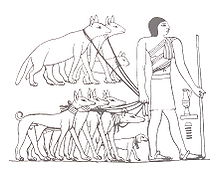Tjesem (greyhound)
| Tjesem in hieroglyphics | |||||
|---|---|---|---|---|---|
| Middle realm |
|
||||
| History of the Sinuhe |
Tjesem ṯzm The greyhound |
||||
Tjesem (also Tschesem, Tesem ) is both the ancient Egyptian name for greyhounds and part of the name of nine Tjesem deities . The Egyptians distinguished nine different colored greyhound types, which is why each type of greyhound was assigned a deity.
In the early dynastic period , for example, King Den used the term Tjesem for wild horde / wild dogs .
Representations

The oldest depiction is the depiction of a curly-tailed dog, which can be seen in Egypt on a bowl from the pre-dynastic period. From the Middle Kingdom onwards there are more and more depictions of this type of dog; especially when designing hunting scenes in graves and on everyday objects.
Its origins could lie in the Sahara , which at that time did not yet have today's desert character , but where steppes or savannas predominated and there were isolated forests in the peripheral areas. It is possible that the pariah dogs, which are still widespread in large parts of Africa , were among his ancestors there.
distribution
The Tjesem is often regarded as the progenitor of the graceful Mediterranean hunting dogs of the Podencos type . Ancient seafarers such as B. the Phoenicians and Carthaginians are said to have been responsible for its spread.
See also
literature
- Frank Kammerzell : Panther, lion and language development in the Neolithic: Comments on the etymology of the Egyptian theonym Mafdet, on the formation of some predatory animal names in Egyptian and on individual big cat names in Indo-European languages. Dedicated to Wolfhart Westendorf on his seventieth birthday . Seminar for Egyptology and Coptic Studies, Göttingen 1994
- Christian Leitz u. a .: Lexicon of the Egyptian gods and names of gods . Peeters, Leuven 2002, ISBN 90-429-1152-2 , p. 502.
